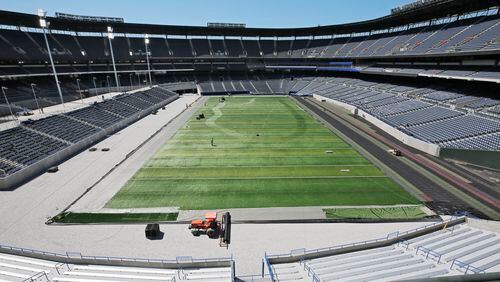Centennial Olympic Stadium/Turner Field/Georgia State Stadium has gone through more identity changes than Ron Artest and Bruce Jenner combined. Submitted to more cosmetic surgery than a Vegas chorus line.
This house has been flipped enough already.
You’d think you’d be used to change occurring off Hank Aaron Dr. (it’s still called that, I guess, until someone gets the idea to get cute and rename it Panther Way). Yet, it was a little jarring Monday to walk into what was the 755 Club – now the University Club – and look down from what used to be a leftfield aerie onto a largely completed football field and an altered configuration of seats.
A rectangle has sprouted up from where a diamond used to be. And an oval before that. They have exhausted even geometry on this little patch of downtown.
What, this is the same place where the infield fly rule once caused a minor riot? Impossible.
Wow, it hits you, Georgia State just got itself a phenomenal place to call its own stadium. Modest Georgia State, a program just turning eight years old, the same program that rattled around the Georgia Dome using barely a fifth of its capacity on a good day, has fallen into a beautiful opportunity.
Wait until the rest of the SunBelt Conference gets a load of this place. Opponents should be required to wipe their feet before stepping onto the new carpet.
Gone were the dugouts where baseball’s best staged two decades of great expectorations. They had been gouged out, along with seven rows of seats where the swells used to take in the Braves between courses of caviar and truffles, we assumed.
Rightfield had been appropriated by a new section of seating. Above it, the Chop House, the place to go when baseball was a secondary interest, still stood. Only it will be called the State House now.
Other gathering areas beyond the outfield will be renamed to reflect the new tenant – like Pounce Town (after the GSU mascot) and Victory Plaza. Frankly, I don’t know what Georgia State is going to do with all this space. It doesn’t exactly know yet, either, choosing to believe that any use beats another stadium implosion.
Georgia State’s new coach, Shawn Elliott, a South Carolinian, is familiar with this building in all its forms. He spent a sweltering summer day of 1996 watching Summer Olympic track and field heats. He and buddies have road-tripped to Braves games. It’s the new purpose, though, that most interests him now.
“We get to be a part of the history of this stadium,” he enthused Monday. “The greatest athletes in the world ran here. The greatest baseball players in the world played here. You’re a part of that. Now, let’s write our own history in this stadium.”
Now, comes the hard part: Making this $30 million or so retrofit pay off in terms of other building projects. Building interest. Building some kind of recruiting advantage. Building a sense of belonging.
As of the Aug. 31 opener against Tennessee State, the most notable thing about Georgia State football is the place where it plays. That isn’t a long-term solution to the ennui that has dogged the Panther program. It is, though, a significant bump until the people in pads do something to consistently put 25,000 backsides in the Turner Field-era chairbacks those same players spent a team work day renumbering.
“We understand that these fans won’t show up if we don’t do what we have to do,” GSU wide receiver Penny Hart said.
There is a great energy around the move to Centennial Olympic Stadium/Turner Field/Georgia State Stadium. There is the pride in ownership that comes with having to share their home with no one. “We can say, ‘This is our own,’” Elliott said.
The coach’s challenge from here is a weighty one – to prove the Panthers have not out-kicked their coverage, facilities-wise, and to put his program on par with the place that houses it.
About the Author







